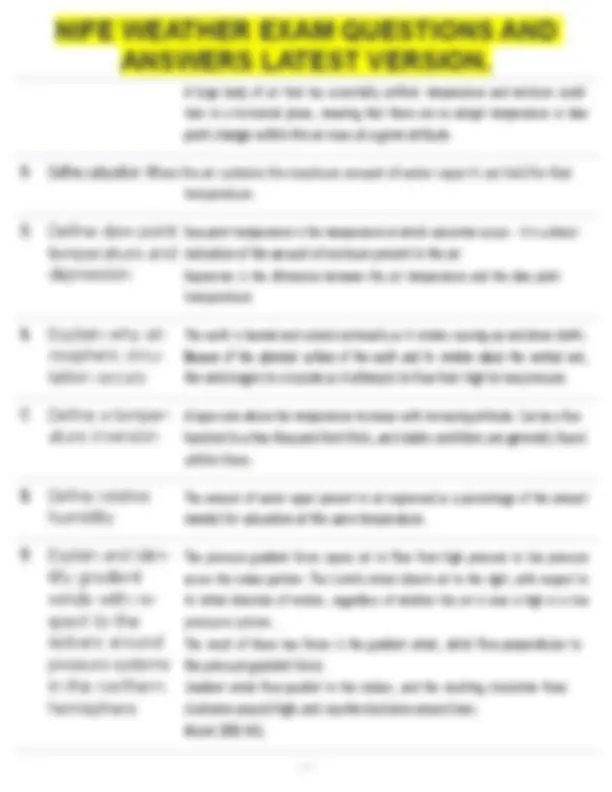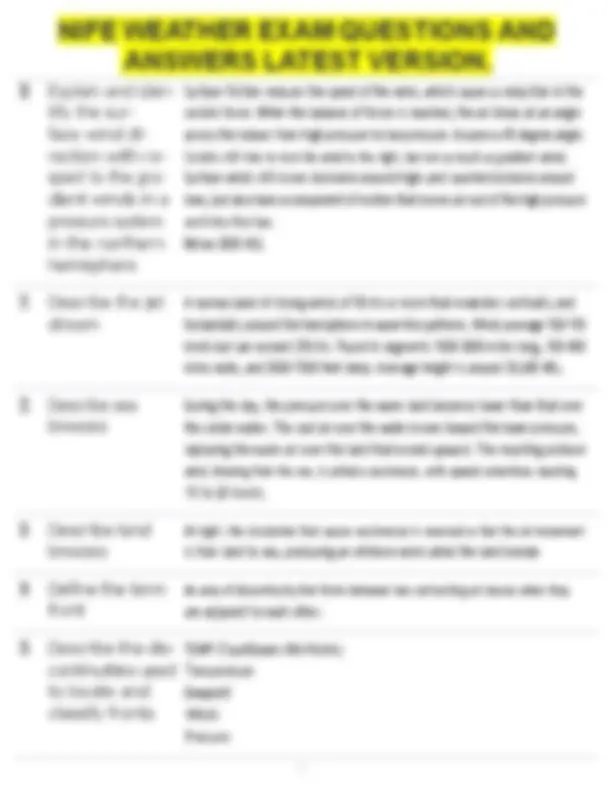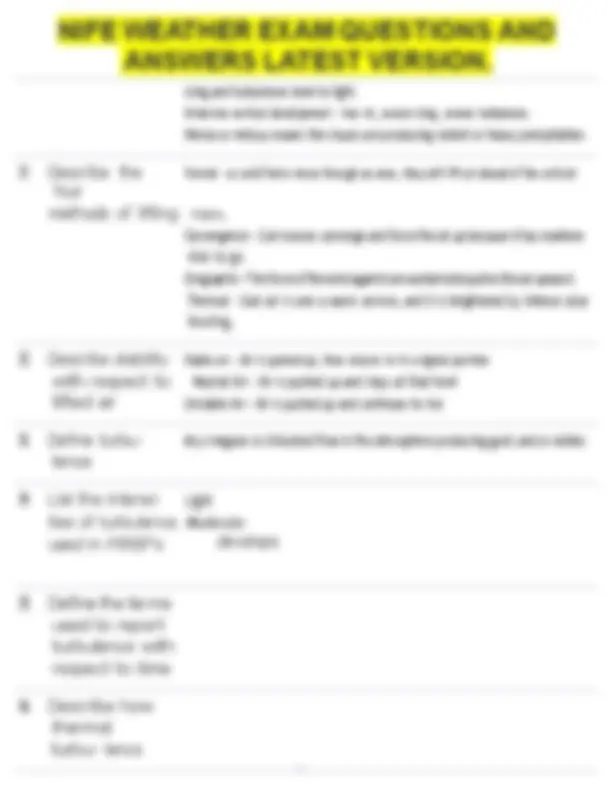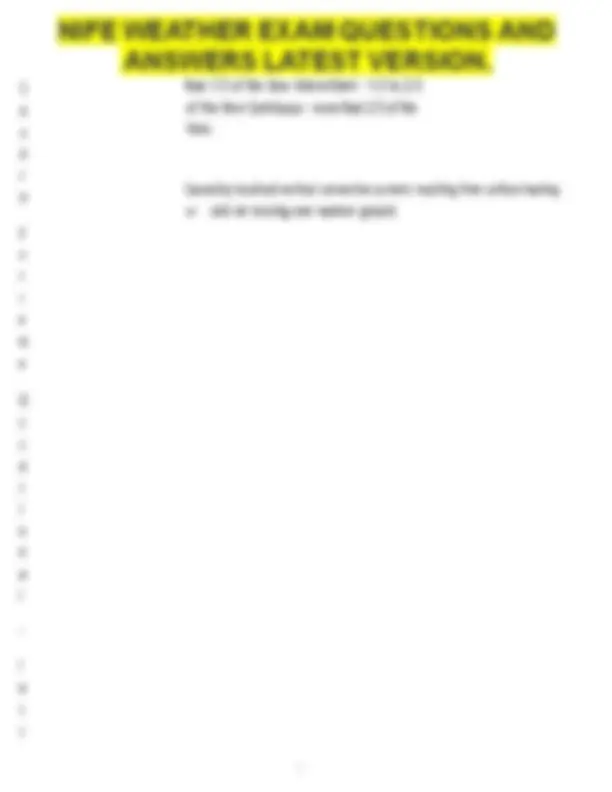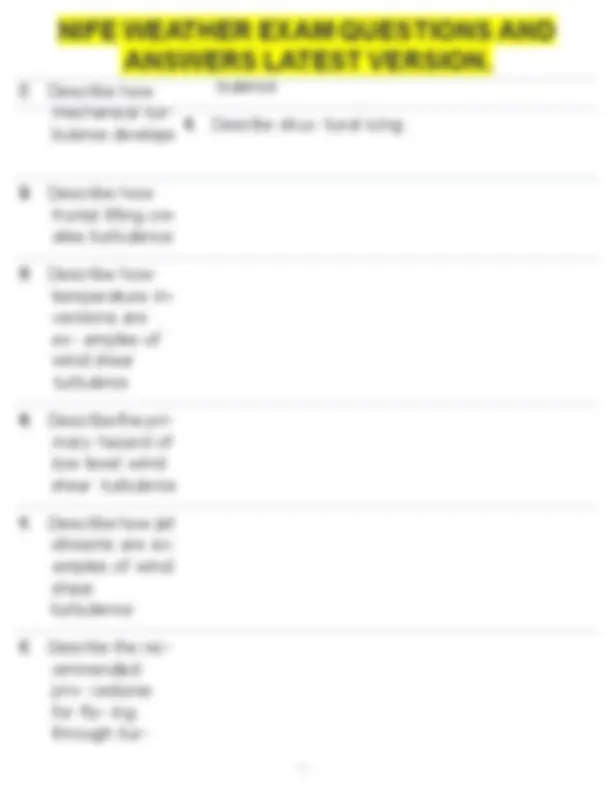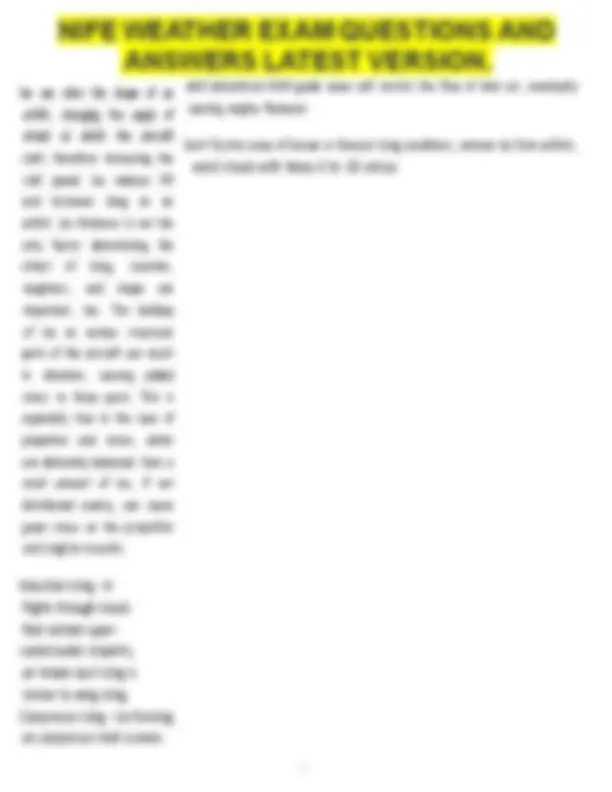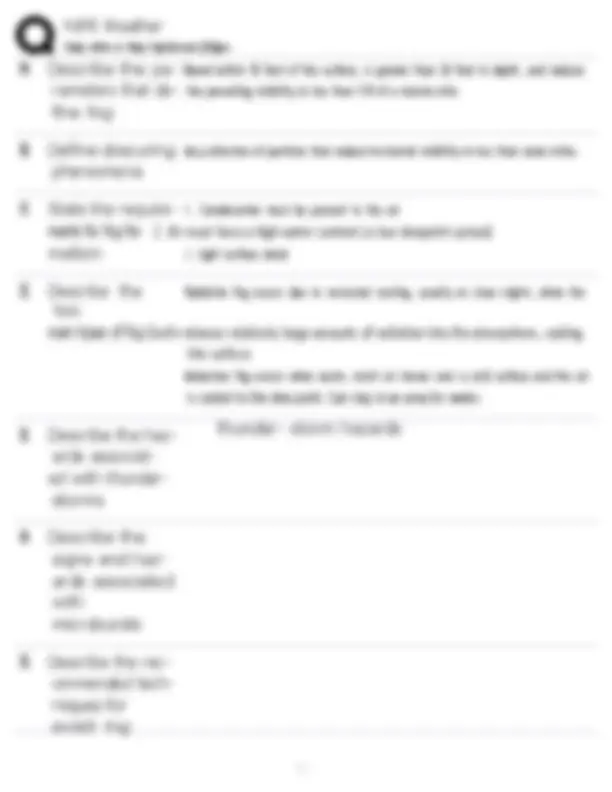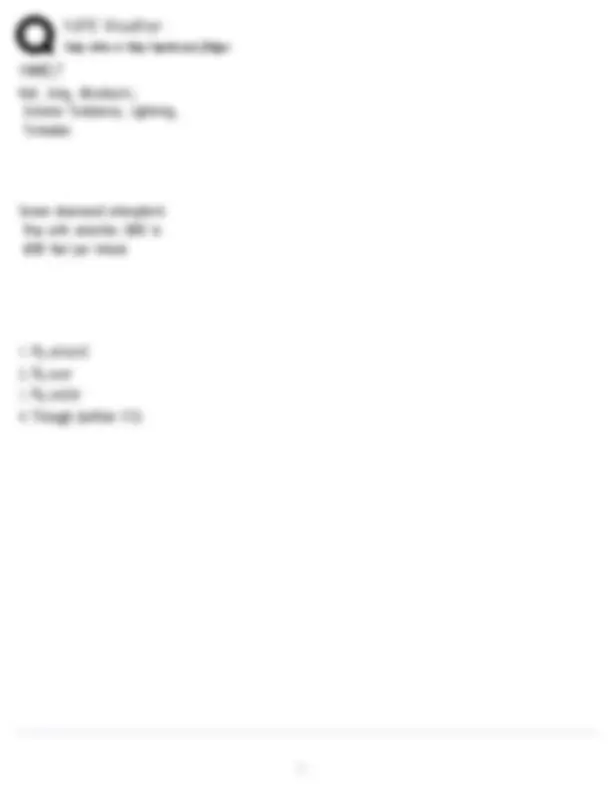Download NIFE WEATHER EXAM QUESTIONS AND ANSWERS LATEST TOP SCORE. and more Exercises Advanced Education in PDF only on Docsity!
1 / 19
NIFE WEATHER EXAM QUESTIONS AND
ANSWERS LATEST VERSION.
- Describe the characterisitcs of the troposphere
- Define atmos- pheric pressure
- State the stan- dard units of pressure mea- surement
- Explain the term pressure gradi- ent
- Define a lapse rate
- State the aver- age temperature lapse rate in de- grees celsius
- Define the stan- dard atmosphere
- Differentiate be- tween sea level The average height of the troposphere is 36,000 feet. Within the troposphere, temperature normally decreases with an increase in altitude. Nearly all winds occur in the troposphere, and increase with altitude. The tropopause is a transition zone between the troposphere and the stratos- phere. 78% nitrogen, 21% oxygen, 1% other The pressure exerted on a surface by the atmosphere due to the weight of the column of air directly above that surface. Always decreases with altitude. Inches of mercury (In-Hg), and millibars (mb) The rate of pressure change in a direction perpendicular to the isobars. Isobar spacing represents the size of the pressure gradient force (PGF). Close together = steep/strong, spaced = shallow/week. PGF is the initiating force for all winds The decrease in atmospheric temperature with increasing altitude A 1000 foot increase in altitude will result in a temperature decrease of 2 degrees celsius (3.5 F) Standard day conditions are sea level, pressure 29.92 in Hg (1013.2 mb) and 15 degrees celsius (59 F) Station pressure is the atmospheric pressure measured directly at an airfield or other weather station.
2 / 19
NIFE WEATHER EXAM QUESTIONS AND
ANSWERS LATEST VERSION.
pressure and sta- tion pressure
- Define the types of altitude
- Define indicated altitude
- Describe the ef- fects of pres- sure changes on the aircraft al- timeters
- Describe the ef- fects of temper- ature deviations from the stan- dard lapse rate on aircraft altime- ters
- Define the term air mass
4 / 19
NIFE WEATHER EXAM QUESTIONS AND
ANSWERS LATEST VERSION.
A large body of air that has essentially uniform temperature and moisture condi- tions in a horizontal plane, meaning that there are no abrupt temperature or dew point changes within the air mass at a given altitude.
- Define saturation When the air contains the maximum amount of water vapor it can hold for that temperature.
- Define dew point temperature and depression
- Explain why at- mospheric circu- lation occurs
- Define a temper- ature inversion
- Define relative humidity
- Explain and iden- tify gradient winds with re- spect to the isobars around pressure systems in the northern hemisphere Dew point temperature is the temperature at which saturation occurs - it is a direct indication of the amount of moisture present in the air Depression is the ditterence between the air temperature and the dew point temperature The earth is heated and cooled continually as it rotates causing up and down drafts. Because of the spherical surface of the earth and its rotation about the vertical axis, the wind begins to circulate as it attempts to flow from high to low pressure. A lapse rate where the temperature increases with increasing altitude. Can be a few hundred to a few thousand feet thick, and stable conditions are generally found within them. The amount of water vapor present in air expressed as a percentage of the amount needed for saturation at the same temperature. The pressure gradient force causes air to flow from high pressure to low pressure across the isobar pattern. The Coriolis ettect diverts air to the right, with respect to its initial direction of motion, regardless of whether the air is near a high or a low pressure system. The result of these two forces is the gradient winds, which flow perpendicular to the pressure gradient force. Gradient winds flow parallel to the isobars, and the resulting circulation flows clockwise around highs and counterclockwise around lows. Above 2000 AGL
5 m/ m 19
NIFE mWEATHER mEXAM mQUESTIONS mAND
mANSWERS mLATEST mVERSION.
- Explain and iden- tify the sur- face wind di- rection with re- spect to the gra- dient winds in a pressure system in the northern hemisphere
- Describe the jet stream
- Describe sea breezes
- Describe land breezes
- Define the term front
- Describe the dis- continuities used to locate and classify fronts Surface friction reduces the speed of the wind, which causes a reduction in the coriolis force. WHen the balance of forces is reached, the air blows at an angle across the isobars from high pressure to low pressure. Assume a 45 degree angle. Coriolis still tries to turn the wind to the right, but not as much as gradient winds. Surface winds still move clockwise around highs and counterclockwise around lows, but also have a component of motion that moves air out of the high pressure and into the low. Below 2000 AGL A narrow band of strong winds of 50 kts or more that meanders vertically and horizontally around the hemisphere in wave-like patterns. Winds average 100 - 150 knots but can exceed 250 kts. Found in segments 1000 - 3000 miles long, 100 - 400 miles wide, and 3000-7000 feet deep. Average height is around 30,000 MSL. During the day, the pressure over the warm land becomes lower than that over the colder water. The cool air over the water moves toward the lower pressure, replacing the warm air over the land that moved upward. The resulting onshore wind, blowing from the sea, is called a sea breeze, with speeds sometimes reaching 15 to 20 knots. At night, the circulation that causes sea breezes is reversed so that the air movement is from land to sea, producing an ottshore wind called the land breeze An area of discontinuity that forms between two contrasting air masses when they are adjacent to each other. TDWP (TouchDowns Win Points) Temperature Dewpoint Winds Pressure
7 m/ m 19
NIFE mWEATHER mEXAM mQUESTIONS mAND
mANSWERS mLATEST mVERSION.
High mClouds m- mabove m20,000 mAGL, mcirro- mor mcirrus, mice mcrystals, mvisibility mgood mto mfair,
8 m/ m 19
NIFE mWEATHER mEXAM mQUESTIONS mAND
mANSWERS mLATEST mVERSION.
- Describe m the m four icing mand mturbulence mnone mto mlight. Extensive mvertical mdevelopment m- mlow mvis, msevere micing, msevere mturbulence. Nimbo mor mnimbus mmeans mthe mclouds mare mproducing mviolent mor mheavy mprecipitation. Frontalm-masmcold mfronts mmove mthroughmanmarea,mtheymwill mliftmairmaheadmofmthemcold mair methods m of m lifting m mass. Convergence m- m 2 mair mmasses mconverge mand mforce mthe mair mup mbecause mit mhas mnowhere melse mto mgo. Orographicm-mThemforcemofmthemwindmagainstmammountainsidempushesmthemairmupward. mThermal m- mCool mair mis mover ma mwarm mservice, mand mit mis mheightened mby mintense msolar mheating.
- Describe mstability mwith mrespect mto mlifted mair
- Define mturbu- mlence
- List mthe mintensi- Stable mair m- mAir mis mpushed mup, mthen mreturns mto mits moriginal mposition m Neutral mAir m- mAir mis mpushed mup mand mstays mat mthat mlevel Unstable mAir m- mAir mis mpushed mup mand mcontinues mto mrise Any mirregular mor mdisturbed mflow min mthe matmosphere mproducing mgusts mand mor meddies Light ties mof mturbulence m Moderate used min mPIREP's
- Definemthemterms mused mto mreport mturbulence mwith mrespect mto mtime
- Describe mhow mthermal mturbu- mlence mdevelops
10 m/ m 19
NIFE mWEATHER mEXAM mQUESTIONS mAND
mANSWERS mLATEST mVERSION.
- Describe mhow mmechanical mtur- mbulence mdevelops
- Describe mhow mfrontal mlifting mcre- mates mturbulence
- Describe mhow mtemperature min- mversions mare mex- mamples mof mwind mshear m turbulence
- Describe mthe mpri- mmary mhazard mof mlow mlevel mwind mshear m turbulence
- Describe mhow mjet mstreams mare mex- mamples mof mwind mshear mturbulence
- Describe mthe mrec- mommended mpro- mcedures mfor mfly- ming mthrough mtur- mbulence
- Describe mstruc- mtural micing
11 m/ m 19
NIFE mWEATHER mEXAM mQUESTIONS mAND
mANSWERS mLATEST mVERSION.
Results mfrom mwind mflowing mover mor maround mirregular mterrain mor mother mobstructions. mWhen mthe mair mnear mthe msurface mof mthe mEarth mflows mover mobstructions, mNormal mhori- mzontal mwind mflow mis mdisturbed mand mtransformed minto ma mcomplicated mpattern mof meddies mand mother mirregular mair mmovements. Caused mby mlifting mof mwarm mair mby ma mfrontal msurface mleading mto minstability, mor mby mthe m abrupt mwind mshift mbetween mthe mwarm mand mcold mair mmasses. Temperature minversion mcan mcause mturbulence mat mthe mboundary mbetween mthe minver- msion mlayer mand mthe msurrounding mlayer. Mostmdangerousmduemtomlocal mphenomenonmsuchmasma mtemperatureminversion There mis ma mrapid mchange min mwind mspeed mwithin ma mshort mdistance mof mthe mjet mcore. mIn morder mto mget mout, mclimb mif mtemp mis mrising, mdescend mis mtemperature mis mfalling. Maintain mpower msetting mconsistent mwith mthe maircrafts mrecommended mairspeed mfor mturbulence mpenetration, mtrim maircraft mfor mlevel mflight, mdo mnot mchase mairspeed mor maltimeter, mmaintain mpitch mand mbank icing mthat mforms mon mthe mexternal mstructure mof man maircraft. mStructural mice mforms mon mthe mwings, mfuselage, mantennas, mpitot mtubes, mrotor mblades, mand mpropellers. mSignificant
13 m/ m 19
NIFE mWEATHER mEXAM mQUESTIONS mAND
mANSWERS mLATEST mVERSION.
Ice mcan malter mthe mshape mof man mairfoil, mchanging mthe mangle mof mattack mat mwhich mthe maircraft mstalls mtherefore mincreasing mthe mstall mspeed. mIce mreduces mlift mand mincreases mdrag mon man mairfoil. mIce mthickness mis mnot mthe monly mfactor mdetermining mthe mettect mof micing. mLocation, mroughness, mand mshape mare mimportant, mtoo. mThe mbuildup mof mice mon mvarious mstructural mparts mof mthe maircraft mcan mresult min mvibration, mcausing madded mstress mto mthose mparts. mThis mis mespecially mtrue min mthe mcase mof mpropellers mand mrotors, mwhich mare mdelicately mbalanced. mEven ma msmall mamount mof mice, mif mnot mdistributed mevenly, mcan mcause mgreat mstress mon mthe mpropeller mand mengine mmounts. Induction micing m- mIn mflights mthrough mclouds mthat mcontain msuper- cooled mwater mdroplets, mair mintake mduct micing mis msimilar mto mwing micing. Compressor micing m- mIce mforming mon mcompressor minlet mscreens mand mcompressor minlet mguide mvanes mwill mrestrict mthe mflow mof minlet mair, meventually mcausing mengine mflameout. Don't mfly minto mareas mof mknown mor mforecast micing mconditions, mremove mice mfrom mairfoils, m avoid mclouds mwith mtemps m 0 mto m- 20 mcelsius
NIFE mWeather Study monline mat mhttps://quizlet.com/_8z0gaw 14 m/ m 19
- Describe mthe mpa- mrameters mthat mde- mfine mfog
- Define mobscuring mphenomena
- State mthe mrequire- Based mwithin m 50 mfeet mof mthe msurface, mis mgreater mthan m 20 mfeet min mdepth, mand mreduces mthe mprevailing mvisibility mto mless mthan m5⁄8 mof ma mstatute mmile. Any mcollection mof mparticles mthat mreduce mhorizontal mvisibility mto mless mthan mseven mmiles.
- mCondensation mmust mbe mpresent min mthe mair ments mfor mfog mfor- m 2. mAir mmust mhave ma mhigh mwater mcontent m(a mlow mdewpoint mspread) mation
- Describe m the m two
- mLight msurface mwinds Radiation mfog moccurs mdue mto mnocturnal mcooling, musually mon mclear mnights, mwhen mthe main mtypes mof mfog mEarth mreleases mrelatively mlarge mamounts mof mradiation minto mthe matmosphere, mcooling mthe msurface. Advection mfog moccurs mwhen mwarm, mmoist mair mmoves mover ma mcold msurface mand mthe mair mis mcooled mto mthe mdew mpoint. mCan mstay min man marea mfor mweeks
- Describe mthe mhaz- mards massociat- ed mwith mthunder- mstorms
- Describe mthe msigns mand mhaz- mards massociated mwith mmicrobursts
- Describe mthe mrec- mommended mtech- mniques mfor mavoid- ming mthunder- mstorm mhazards
NIFE mWeather Study monline mat mhttps://quizlet.com/_8z0gaw 16 m/ m 19
- Define mthe mtypes mof mvisibility
- Describe mthe msky mcoverage mterms mthat mdefine ma mceil- ming
- Describe mthe muse mof mPIREP's
- Describe min-flight mweather madvi- msories Flight mVisibility m- mThe maverage mforward mhorizontal mdistance, mmeasured min mstatute mmiles mfrom mthe mcockpit mof man maircraft min mflight, mat mwhich ma mpilot mcan msee mand midentify mprominent munlighted mobjects mby mday mand mprominent mlighted mobjects mat mnight. Prevailing mVisibility m- mThe mgreatest mhorizontal mvisibility, mmeasured min mstatute mmiles, mequaled mor mexceeded mthroughout mat mleast mhalf mthe mhorizon mcircle, mwhich mneed mnot mbemcontinuous. Slant mRange mVisibility m- mThe mdistance mon mfinal mapproach mwhen mthe mrunway menviron- mment mis minsight. mThis mis mprobably mthe mmost mvital mweather minformation mneeded mduring ma mfinal mapproach min mquestionable mweather. Runway mVisual mRange m(RVR) m- mThe mhorizontal mdistance, mexpressed min mhundreds mof mfeet mormmeters, ma mpilot mwillmsee mby mlooking mdown mthemrunway mfrommthe mapproach mend. SKC/CLR m- mSky mClear, m0/ mFEW m- mfew, m0/8 m- m2/ mSCTm-m3/8 m-m4/ BKN m- mBroken m- m5/8 m- m7/ mOVC m- mOvercast m- m8/ VVm-mVerticalmVisibilitymObscuredm-m8/ Report mwhen: Inflight mrequested Unusual mor munforecast mweather Weather mconditions mare mditterent mfrom mthe mlatest mobservation mMissed mapproach mdue mto mweather Wind mshear mon mdeparture mPIREP's,mATIS
NIFE mWeather Study monline mat mhttps://quizlet.com/_8z0gaw 17 m/ m 19
- Describe mthe muse mof msurface manaly- msis mcharts
- Describe mthe muse mof mweather mprog- mnostic mcharts The mSurface mAnalysis mChart mdepicts mpressure mcenters, mfronts, mand mbarometric mpres- msure mlines. Represents mpast mhistory, mand mis mnot ma mforecast. Include mthe mlatest msurface manalysis malong mwith mmultiple mforecasts mup mto ma mweek. mDepict mpredicted mpositions mof mfronts mand mpressure mcenters, mas mwell mas mforecast mweather macross mthe mcountry.
- Identify m the m infor- m Temp mover mdewpoint, maltimeter msetting, mceiling, mICAO, mwindbarb, mvisibility, mand mationmdisplayed mon mstation mmod- mels
- Describe mthe muse mof mMETARs min mflight mplanning
- Describe mthe muse mof mTAF's min mflight mplanning
- Describe mthe muse mof mwinds-aloft mforecasts
- Describe mthe muse mof mground mbased mweather mradar
- Describe mthe muse mof msatellite mim- magery weather. Provides ma mrapid mand meflcient mmeans mof mtransmitting mthe mlatest mobserved mweather minformation mfor mvarious mstations mthroughout mthe mworld This mteletype minformation mwill malso maid myou min mplanning mfor mthe mtype mof mflight m(IFR/VFR), mtype mof mapproach myou mrequire, mdetermining mif man malternate mis mrequired, m and mselection mof mthe mbest malternate. Present mthe mobserved mand maverage mforecast mflight mlevel mwinds maloft. m####+## m2212+11m= mWindsm 12 mktsmatm 220 mdegrees,mtempm 11 mcelsius.mAllmTempsmnegativemabove m24,000. NEXRAD mshows mhail, mtornadoes, mmicrobursts m, mand mwind mshear m(HTMW) Primarily mused mto mdetermine mthe mpresence mof mclouds mand mthe mtype mof mclouds mfrom mshape mand mtexture.
NIFE mWeather Study monline mat mhttps://quizlet.com/_8z0gaw 19 m/ m 19 Describe msevere mweather mwatch mmessages
- List mthe mmeth- modsmof mobtaining mweather mbriefin- mgs
- State mthe mrequire- mmentsmfor mobtain- ming ma mpreflight mweather mbriefing Get ma mDD- 175 - 1 m(Dash m1), mcall m 1800 - WXBRIEF


